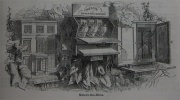1851 Great Exhibition: Official Catalogue: Class IX.: John Milton
291. MILTON, JOHN, 10 Great Mary-le-bone Street — Producer.
The "Royal Alfred Hive." This is the centre hive in the illustrations. This hive is conveniently adapted for the purpose of taking the honey without destroying the bees; and is suitable for the conservatory, library, or any room where the sun's rays come during some portion of the day.
The Town Mansion Hive. The inmates of this hive consist of four first swarms of July, 1850, from four distinct families or stocks or bees; thus demonstrating that a very considerable number of bees from various queens will work together in perfect harmony. They have been kept until now in a secluded spot bordering upon a heath.
The Unicomb or Mirror Hive. The "unicomb," or one-comb hive, is so constructed that the movements of every bee can be observed.
In addition to the bees contained in the glass case, are various beehives made of cork, wood, and straw. There are also models of beehives and apiaries, and a glass of honey gathered in the year 1837. This specimen is exhibited to prove the extraordinary length of time pure honey can be preserved. It weighs 26 lbs.
Bar and frame hive, invented by William Augustus Mann, Esq., Throwley House, near Feversham, Kent.
The advantages claimed consists in the whole of the interior of the hive being open to inspection at any moment, and a choice can be made of the combs containing the most honey, etc., and this without the assistance of smoke, as each bee-frame, and the bees and combs contained in it, can be drawn up and examined in the observation frame (as shown in the adjoining sketch) without interfering with any other part of the hive; or occasioning the loss, or even escape of a single bee. The hive is shown in operation, with the comb brought into the observation frame; one frame is also seen through the side of the box, to show how it is suspended in the triangular case.



